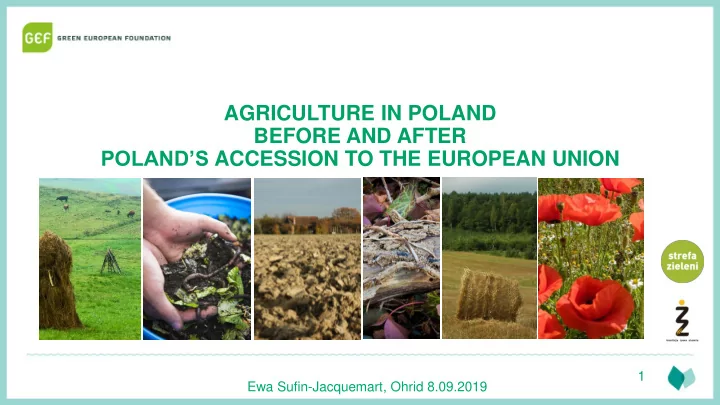

AGRICULTURE IN POLAND BEFORE AND AFTER POLAND’S ACCESSION TO THE EUROPEAN UNION 1 Ewa Sufin-Jacquemart, Ohrid 8.09.2019
AGRICULTURE IN POLAND BEFORE 2004 AND TODAY Poland is ranked the 3rd in EU in terms of arable land, after France and Spain, but has poorer soil quality and a shorter vegetation period. After the fall of industry due to the 1990 transformation, many people from cities moved to the countryside. State owned farms falled, small farmers could not compete with imported products. Farm families have become multi-income. BEFORE 2004 TODAY Rural population: 38% of the total population, 58% of the rural Rural population: 38% of the total population, 22% associated with population associated with agriculture agriculture Employment: 20,2% of the total number of employees are Employment: 10,2% of the total number of employees are associated with farming (2000) associated with farming (2017) Part of GDP : 3,3% (UE: 1,5%, Grece: 5,8%, Sweden: 0,4%) – PL: 11,8% in 1989, 6% in 1996 Part of GDP: 2,6% (2016) Number of farms : 2,138 milion in 1990, 1,882 milion in 2004 Number of farms: 1,425 milion in 2018 Arable land : approx. 17 million ha (approx. 54% of the total area of Arable land: approx.. 16,4 millions ha (2018) the country) Average size of farm : 8,3 ha, twice smaller than the average size in EU, 55% of farms with 1-5 ha of farmland, 0,4% of farms with Average size of farm: 10,4 ha (2018) , 74% of farms 1-5 ha (28% of +50ha of farmland farmland), 0,5% of farms of +500 ha = 7% of farmland (2018), Low price of agricultural land , esp.. in North/West High price of agricultural land: especially in fruit production basins 2 Ewa Sufin-Jacquemart, Ohrid 8.09.2019
AGRICULTURE IN POLAND BEFORE 2004 AND TODAY . TODAY BEFORE 2004 Farm structure: still fragmented but some less Farm structure: very fragmented, 25% consisting through the concentration of fields of one plot, 7% of 10 plots and more Traditional character of agricultural production : Character of agricultural production : very multidirectional production, extensive methods specialised and/or industrial production of crops Economic Size Unit* of farms : 96% <8 ESU and industrial breeding of animals are developing very quickly ( high debt of farmers) Structure of family income in 2000 (farmers) : agriculture 36%, work outside agriculture 29%, social benefits 30%, non-agricultural activities 4% Structure of family income: agriculture 10%, work (1990: 55%,29%,12%,2%) outside agriculture 49%, non-agricultural activities 7%, social benefits 33% Income of the rural population : 19% farming only, ,15% farming + other activity, +51% non- agricultural income Income of the rural population: 11% farming only, +30% od farms produce only for their own needs Trade: from 1992 to 2004 Poland was a net importer of agricultural products Trade: Agricultural product exports have increased more than four times since 2004. 1 ESU=1200 EUR of standard direct surplus 3 Ewa Sufin-Jacquemart, Ohrid 8.09.2019
CONCLUSIONS EFFECTS OF TRANSFORMATION AND EU ACCESSION Those processes have produced both positive and negative effects: Positive effect: the improvement of the economic situation in rural areas: • the level of extreme poverty decreased from over 18% in 2000 to 7.3% in 2017, • the income of rural residents per capita increased by 118% (urban residents by 94%) • the fragmentation of farms has been reduced • many harmful practices have been eliminated in Poland, such as burning grasses, storing manure directly on the ground or using fertilizers for frozen soil, • the creation of fish ponds created water retention systems and has positive effect on biodiversity • organic farming has developed quickly after 2004, with a pic in 2013 of 670.000 ha of crop area (4,7%) and almost 27.000 farms. 4 Ewa Sufin-Jacquemart, Ohrid 8.09.2019
CONCLUSIONS EFFECTS OF TRANSFORMATION AND EU ACCESSION Negative effects : • migration of young people from rural areas to cities or abroad, • emergence of industrial farms, especially industrustrial breeding of poultry, pigs and cows (that develop very quickly!) • collapse of many small farms, • income stratification of rural populations: ab. 20% of farms are large producers who produce exclusively for the market; +50% of medium-sized farms that hardly try to make a living from commercial production, 15% don’t produce anything just keep the land in good agricultural condition, 15% produce only for themselves. • the increasing pressure on profit causes that traditional techniques are replaced by industrial cultivation and farming methods (organic farmic is quasi not taught in schools of agriculture) • In 2017, Polish farmers used 30% more mineral fertilizers annually than when they joined the EU. • The amount of chemical plant protection products consumed increased by five times from 1991 to 2017. 5 Ewa Sufin-Jacquemart, Ohrid 8.09.2019
CONCLUSIONS EFFECTS OF TRANSFORMATION AND EU ACCESSION Negative role of Polish political elites : • Poland has allowed global corporations of agribusiness and agrochemistry to take over of seed centers and the sale of agricultural inputs, • Polish agricultural policy supports intensive agriculture and underestimates the environmental and social benefits of smaller farms, • The share of agri-environmental payments of the EU Common Agricultural Policy is one of the lowest in the EU, e.g. in 2014-2020 it is only 8.6%, almost 10 times less than e.g. in Austria; Poland was the only EU country that transfered 25% of those funds for the direct payments; • Lack of high-quality soil protection: Poland has only 3.7% of high quality arable land that disappears as a result of urbanization and road construction. • Lack of suport for organic farming: the numer of farms and the crop area is reduced by 6% per year since 2014. 6 Ewa Sufin-Jacquemart, Ohrid 8.09.2019
The Baltic Sea – blooms of cyanobacteria Ewa Sufin-Jacquemart, Ohrid 2019 7
Recommend
More recommend